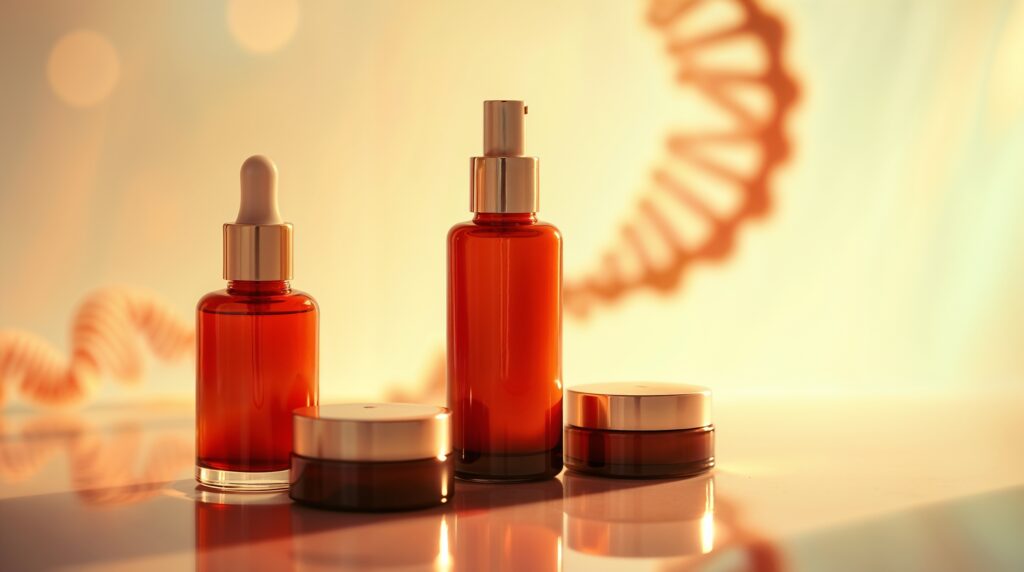Original content brought to you by our partner CLR Berlin.
From Extreme to Mainstream
Enhancing Minimally Invasive Beauty with Pre- and Post-Treatment Skincare
Beauty has been an eternal theme throughout the history of humanity. We are increasingly focused on our appearance and hope to stay young, beautiful and healthy as we age.
Lasers, baby-botox, fillers, needling, chemical peels, face threads – OMG, the list is endless! So-called ‘Minimal-Invasive’ skin treatments, known for their fast results and minimal downtime, are increasingly popular. Admittedly, no cream can replicate the effects of surgical facelifts, eyelid lifts, or laser treatments, especially for challenging skin issues like uneven texture, acne scars, or severe UV damage. This raises an interesting question: In the future, will we opt for hyaluronic fillers over hyaluronic face creams? The growing significance of cosmetics tailored to support the skin before and after aesthetic treatments should not be underestimated. Specialized skincare products can play an important role in improving treatment outcomes and reduce recovery time. This trend offers new product development opportunities for brands and a targeted solution to consumers’ concerns.
The Fog of Treatments and Procedures in the Aesthetic Industry
Aesthetic surgery has been around for decades and is constantly evolving. Plastic surgery, intended to improve facial appearance, has been practiced for more than 100 years. Jacques Joseph, considered the father of modern facial plastic surgery, developed many of the earliest surgical technologies, known as invasive procedures (1). The term ‘invasive’ is typically used to describe surgical procedures that require incisions and appreciably alter skin or underlying tissues at the time of the procedures. This class of procedures, for example, a facelift or liposuction, requires bed rest for a few days up to a few weeks. However, nowadays, there are more ways than ever to address aesthetic cosmetic concerns.
In recent years, non-invasive, or more accurately, minimal-invasive facial beauty, has evolved rapidly. Due to technological advancements, these types of cosmetic procedures are gaining popularity as alternatives to traditional aesthetic surgery (2). The level of invasiveness in such treatments varies, and the terminology used to describe their mechanisms can often be confusing, depending on the definition of the terms and who is defining them.
Minimal-invasive cosmetic treatments require significantly less or no downtime and very little discomfort, but often involve a puncture or even a small incision. These procedures encompass a range of treatments such as neurotoxins, dermal fillers, chemical peels, and microneedling. Injectables and skin resurfacing techniques target specific facial irregularities, including wrinkles and fine lines, loss of volume and contour, unwanted fat or stubborn pigmentation. Particularly laser technology offers numerous options for plastic surgeons or dermatologists. Furthermore, the topic of minimal-invasive methods has gained attention among scientists, with a vast array of studies focusing on the aesthetic applications of neurotoxins and dermal fillers (3,4).
And then there are the non-invasive treatments. These skincare treatments are classified as non-invasive because they do not puncture the skin or impact the underlying tissues. Such treatments are typically very comfortable and relaxing, delivering instant results and well-being benefits to the skin. Common examples of non-invasive treatments are classic facials, which improve skin quality by cleansing, exfoliating, and moisturizing the epidermis.
Furthermore, there is a substantial gray area of ‘high-tech’ cosmetic treatments (e.g., the use of strong light sources), which are often performed by practitioners and categorized as non-invasive or minimal-invasive. Unfortunately, procedures conducted by underqualified practitioners have resulted in consumers experiencing serious adverse effects. To address this, the British Association of Beauty Therapy & Cosmetology (BABTAC) has launched an initiative to help consumers find safe beauty services (5). Globally, regulations and minimum standards for training and licensing to perform minimal-invasive and non-invasive aesthetic treatments are being established to ensure they are safe, ethical, and effective. A professional consultation prior to any treatment is crucial to mitigate risks and minimize potential side effects.
Between Reality and Virtuality – Zooming in on the Modern Aesthetic Consumer
In an era where digitalization and social media are prevalent and filters are omnipresent, consumers have become increasingly conscious of their appearance. Millennials, in particular, are at the forefront of this trend, emerging as the ‘New face of aesthetic treatments’ (5), heavily influenced by the internet, television, and social media. They are starting to focus on their skin and skin health earlier rather than later in life. But the heightened awareness has also led to a rising adoption of aesthetic procedures among men, Gen Z, as well as older generations.
According to the International Society of Aesthetic Plastic Surgery (ISAPS), 14.9 million surgical (invasive) and 18.8 million non-surgical (minimal-invasive) procedures were performed by plastic surgeons worldwide in 2022 (6). The ISAPS report indicates a continual increase in aesthetic surgery, with a notable increase of 41.3% over the last four years, and an even more significant rise of 57.8% in non-surgical procedures. Women form the majority of all aesthetic procedure recipients, although the number of men undergoing these treatments is on the rise. Botulinum toxin remains the most common minimal-invasive procedure for both men and women globally. Following this are dermal fillers and facial skin treatments, such as lasers, chemical peels, and HydraFacials.
The US and Brazil are estimated to have the highest number of plastic surgeons, with Japan, China, and South Korea following closely, and each region exhibiting distinct preferences for different procedures.
With the Covid-19 pandemic, the number of aesthetic procedures has further increased. The pandemic lockdown and the new digital world of work have led some consumers to become more conscious about the appearance of their skin. The prevalence of long video calls has brought attention to perceived facial flaws, while social distancing has provided an opportunity for surgical procedures to heal unnoticed.
As a result, the variety of aesthetic applications has expanded, with the new digital world acting as a catalyst for this growth. Attitudes towards these procedures are shifting, and consumers are increasingly incorporating them into their overall lifestyle, viewing them as part of age-related preventive skincare that offers both efficacy and convenience.
Synergies between Skincare and Aesthetic Procedures
The increasing global demand for invasive, and especially minimal-invasive, aesthetic treatments is undeniable. However, it’s important to recognize that aesthetic treatments, regardless of their popularity, are not miracle cures. With the abundance of information available, many patients seek aesthetic services, yet they often overlook that their current skin health has significant impact on the result. Several factors influence the course of the treatment and the final outcome, including age, genetics, skin type, phototype, lifestyle, and more. Plastic surgeons, dermatologists, aestheticians, and beauty influencers agree that the success of each treatment is highly dependent on the pre-treatment health and quality of the skin. Well-moisturized skin with minimal UV damage is generally considered an ideal starting point for aesthetic procedures, underscoring relevance for the use of facial skincare creams.
Regardless of the method or targeted outcome, aesthetic treatments essentially apply some form of controlled damage to specific skin areas to achieve a desired aesthetic result. Proper pre- and post-skincare treatments are fundamental for appropriate healing of the skin. This is especially true for high-energy treatments like lasers or various types of chemical peels (7).
Notably, there are relatively few official guidelines or legislation worldwide on this topic. Most of the scientific work in this field is based on the experience and assessment of therapists.
A group of experts in cosmetic surgery and dermatology have formulated recommendations to optimize outcomes in supportive skincare before, during, and after invasive or minimal-invasive procedures (8). The main goals of a post-treatment skincare routine are soothing skin sensitivity and redness, preventing post-inflammatory hyperpigmentation, improving wound healing while minimizing scarring, and preventing inflammation and treating UV-sensitivity. Implementing a supportive skincare regimen, which includes preparing, cleansing, and protecting the skin, is recommended to accelerate the regeneration phase and minimize downtime, thereby maximizing the benefits and longevity of results from the procedures.
The outlook: Minimally Invasive Techniques and Skincare Synergies
Research indicates that the focus in cosmetic surgery is increasingly shifting towards minimal-invasive treatments, which are characterized by short downtime and rapid regeneration phases (9). According to Mintel, 42% of US adults agree that undergoing non-invasive surgery to enhance one’s appearance is acceptable (10).
The scalpel is on its way to becoming a less utilized tool in cosmetic surgery and dermatology. As technology advances, the traditional treatment cabin, once known for classic facials, is transforming into a technology center capable of delivering ‘surgery-like’ results for the skin. Medical spas are merging the realms of medicine and aesthetics to offer cosmetic treatments in a spa-like ambiance. This blend of aesthetic medicine, technology-driven cosmetic treatments, and the rising wellness trend for beauty enhancement is shaping the future of the cosmetic industry. For a range of minimal-invasive procedures, consulting an experienced professional is crucial to achieve natural results on and within the skin, ensuring a fresh, healthy appearance while managing the associated risks. However, these minimal-invasive procedures can represent a significant financial commitment for consumers.
Skincare products that are suitable for accompanying aesthetic procedures are important, but more significantly, cosmetic products tailored to individual skin types can protect and nurture the skin, potentially delaying the need for aesthetic medical procedures as long as possible. With a focus on the quality and efficacy of ingredients in skincare products, consumer confidence in these cosmetic products will be further enhanced.
Embracing a conscious and healthy lifestyle, maintaining a suitable skincare routine, and ensuring good sun protection are key to supporting healthy and glamorous skin, helping you to be the best version of yourself. At CLR, we are passionate about this!
References:
- “Jacques Joseph: Father of modern aesthetic surgery“, Indian J Plast. Surg. 41 (Suppl), PMCID: PMC2825133 PMID:20174541, 10/2008
- “Non-surgical Cosmetic Procedures Market Analysis North America, Europe, Asia, Rest of World (ROW) – US, Mexico, Brazil, Germany, Japan – Size and Forecast 2023-2027“, Technavio, 10/2023
- “Medical Aesthetics-Current trends and a Review of Its Applications“, Arora, Gulhima; Arora, Sandeep, Indian Dermatology Online Journal, 10/2022
- “Minimally Invasive Facial Cosmetic Procedures“, Devgan, Lara; Singh, Priyanka; Durairaj, Kamala; Otolaryngologic Clinics of North America, 02/2019
- “Minimally Invasive Facial Cosmetic Procedures for the Millennial Aesthetic Patient“, Mobayed, Nisreen; Nguyen, Julie; Jagdeo, Jared; PMID: 32395973, DOI: 10.36849/JDD.2020.4641, 01/2020
- “ISAPS – Global Survey 2022“, ISAPS, 09/2023
- “Prä- und postinterventionelle Hautpflege bei Laser- und Peelingbehandlungen“, Panhke, F.; Peckruhn, M.; Elsner, P.; Springer, 03/2021
- “Expert recommendations on supportive skin care for non-surgical and surgical procedures“, Amici, Jean-Michel; Cogrel, Olivier; Jourdan, Marie; Raimbault, Catherine; Canchy, Ludivine; Kerob, Delphine; Madfes, Diane; Tian, Yan; Araviiskaia, PMID: 36635618, DOI: 10.1111/jdv.18855, 03/2023
- “Non-invasive Aesthetic Treatment Market Size, Share & Trends Analysis Report By Procedure (Skin Rejuvenation, Injectable), By End Use (Hospital/Surgery Center, MedSpa), By Region, And Segment Forecasts, 2022 – 2030“, Market Research.com, 01/2022
- “Beauty Disruptors: skincare for cosmetic procedures”, Mintel, 08/2023









